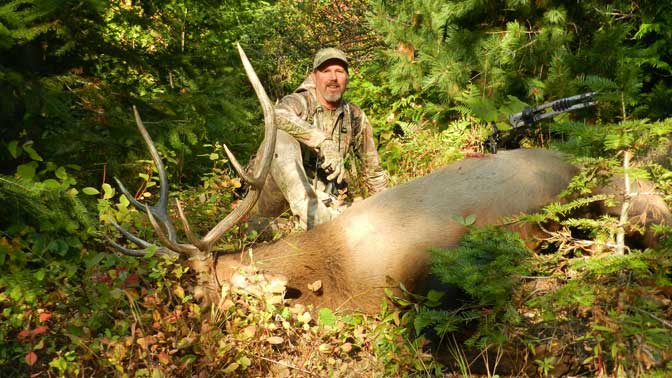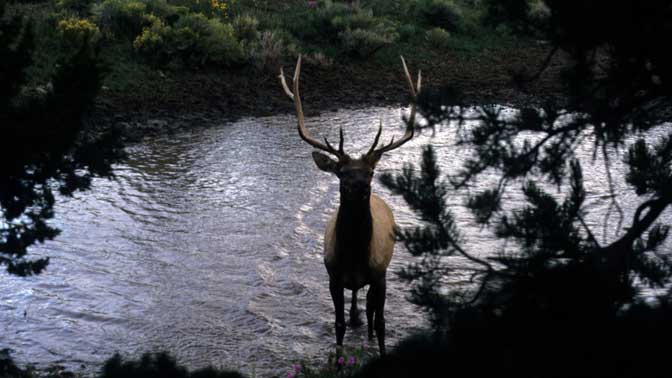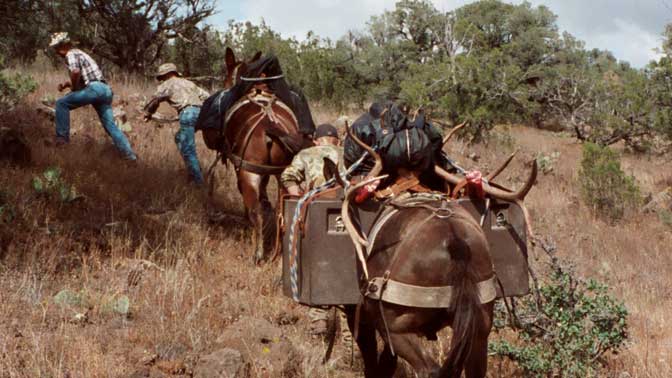In many states bowhunting elk during designated rifle seasons is legal.
But is it worth the effort?
Bowhunting during rifle seasons is fairly common in many Western states, such as Idaho and Montana, for instance. In most states, though, hunters are required to pick a season and stick with it, though choosing a rifle-specific hunt opens the option of hunting with any legal weapon, including bows, as game managers seldom care if you wish to unduly handicap yourself. The real question is, of course, is it really worth doing? Rifle seasons in some areas can resemble all-out wars, with accompanying ATV traffic, much boisterous target practice and an invasion of pumpkin-clad hunters stirring up the woods. But scheduling conflicts, finding yourself still with a tag after archery seasons have closed (when legal to continue hunting) or working around available vacation time means we sometimes hunt when we have to, not when we want.
I can tell you for certain that I’ve killed my share of white-tailed deer with a bow during ongoing rifle seasons. It’s pretty much par if you want to hunt the rut in the Gem State, while scheduling issues have meant I’ve also done so in states like Nebraska and Kansas. Are elk any different? Yes and no. Elk aren’t whitetails, generally tolerating less intrusion and human activity, but when there is no other option, bowhunters can turn lemons into lemonade by changing tactics to meet the unique demands to find success when bowhunting elk during gun season.

You’ll have to turn your game up a notch, but killing a bull with your bow during gun season can be done.
Making Use of Crowds
The added confusion of rifle seasons can actually work to your advantage, but only with a smart approach and careful planning. The basic plan involves letting crowds to work for you, allowing them to drive elk past obvious funneling points while you wait in ambush. And while this is the basic outline, the details become a bit more complicated.
Knowing your hunting area well helps tremendously. There will always be places—roads, trailheads, parking areas and such—that predictably concentrate hunter activity. These are obvious starting points for the masses, and where the big elk drives will typically begin. It’s also imperative to know where concentrations of elk will be found prior to season opener. The weeks between bowhunting-season close and rifle opener are tranquil times for elk herds. They regroup and engage in much of their annual breeding during this temporary reprieve. In many cases they become highly visible, taking to open meadows, ranch hay fields and similar places to breed and where they’re easily scouted and observed. These big herds won’t go unnoticed by the masses either—which actually works to your advantage, as the public is sure to concentrate on these areas opening morning. They might shoot a few of those elk, but they never get them all.
The trick is studying the situation and asking yourself what route those elk will take to reach refuge once the shooting begins. This might be wholly obvious; off-limits private lands, deeper wilderness, adjacent tangled cover. In one area of New Mexico, the escape cover was across a fence and into another state (Arizona) with different hunt dates. Your job is then to determine what available features will best funnel elk past a stationary position you occupy via tree-stand or blind.
Poring over topographical maps is always a good place to start. Ridge points, saddles and timbered draws cutting open terrain are all good bets, the most obvious Point-A to Point-B routes that also keep elk under cover until safety is reached. Fence breaks are often great ambush sites as well. Thorough scouting is a big part of success here.
After you’ve determined a good ambush point, go the extra mile to arrive well ahead of competition and set up before the hoopla begins. The easiest way to accomplish this in most cases is to backpack “behind enemy lines” before season opener, making it easier to be on hand well before shooting light arrives. In other cases, such as guarding gaps into private properties, waking a couple hours earlier is a wise investment. Too, don’t be in a hurry to abandon your post, as elk can arrive any time of the day in such situations, elk jumped from beds or pushed from thick cover making for safer ground as Joe Public advances. Take a paperback, a lunch and fluids and make a day of it.
Water Magnets
Allowing crowds to work for you, obviously, is an opening-day through second-day ploy. After the initial rush is completed without receiving a shot, Plan B is in order. In drier portions of elk habitat don’t ignore water-holes as a bowhunting option during earlier rifle seasons. All that commotion causes a lot of traveling and running that easily works up a thirst. During my 23 years as a big-game guide in New Mexico, even during rifle season it was common to stake out water with out-of-shape or elderly hunters unable to hike rough and tumble country. We tagged a lot of bulls over water in the heat of ongoing rifle seasons.
Finding hidden springs or remote waterholes makes this approach most productive. The best aren’t found on maps, but unless you know your hunting grounds well this isn’t likely. Still, during scouting trips, any time you come across conspicuous trails, see where they are headed. As other trails join the main track they create arrows pointing the way. I have found pockets of water in small canyon heads or rock bowls that attracted elk quite reliably, and were not marked on maps. I only discovered these watering sites by curiously following beat-down trails.
The obvious approach here is a tree-stand, or a natural ground blind if a decent stand tree is unavailable. Keep the wind in mind and invest in long days. You never know when a thirsty elk will arrive when they’re being harassed by enthusiastic hunters.

Don’t overlook waterholes. Elk will still visit these spots when the pressure is on during gun season.
Get Away From It All
Of course, the best way to avoid the rifle-hunting confusion is to backpack or pack-string with horses or mules into deep wilderness fewer hunters penetrate. There will always be a few ambitious hunters, and obligatory outfitter camps, found in remote wilderness areas, but nothing like the masses found in more accessible ground. Wilderness areas are normally quite obvious, thoroughly marked on maps and trailheads, but in other cases extra-rough country can create defacto wilderness by a simply lack of roads, and a nasty ridge or deep canyon that detours the less ambitious. Putting in the extra effort, starting out earlier than everyone else, puts you into these lightly-hunted areas where elk just might not know they’re being hunted.

Get away from the crowds…find more critters.
Choosing a bow and arrow during open rifle season means you will have your work cut out for you. But it certainly isn’t impossible, if you’ll heed these tips and go the extra mile to make something happen. Make the best of the crowds, or leave them behind completely, and you can get your elk despite the archery handicap.

 By
By 



